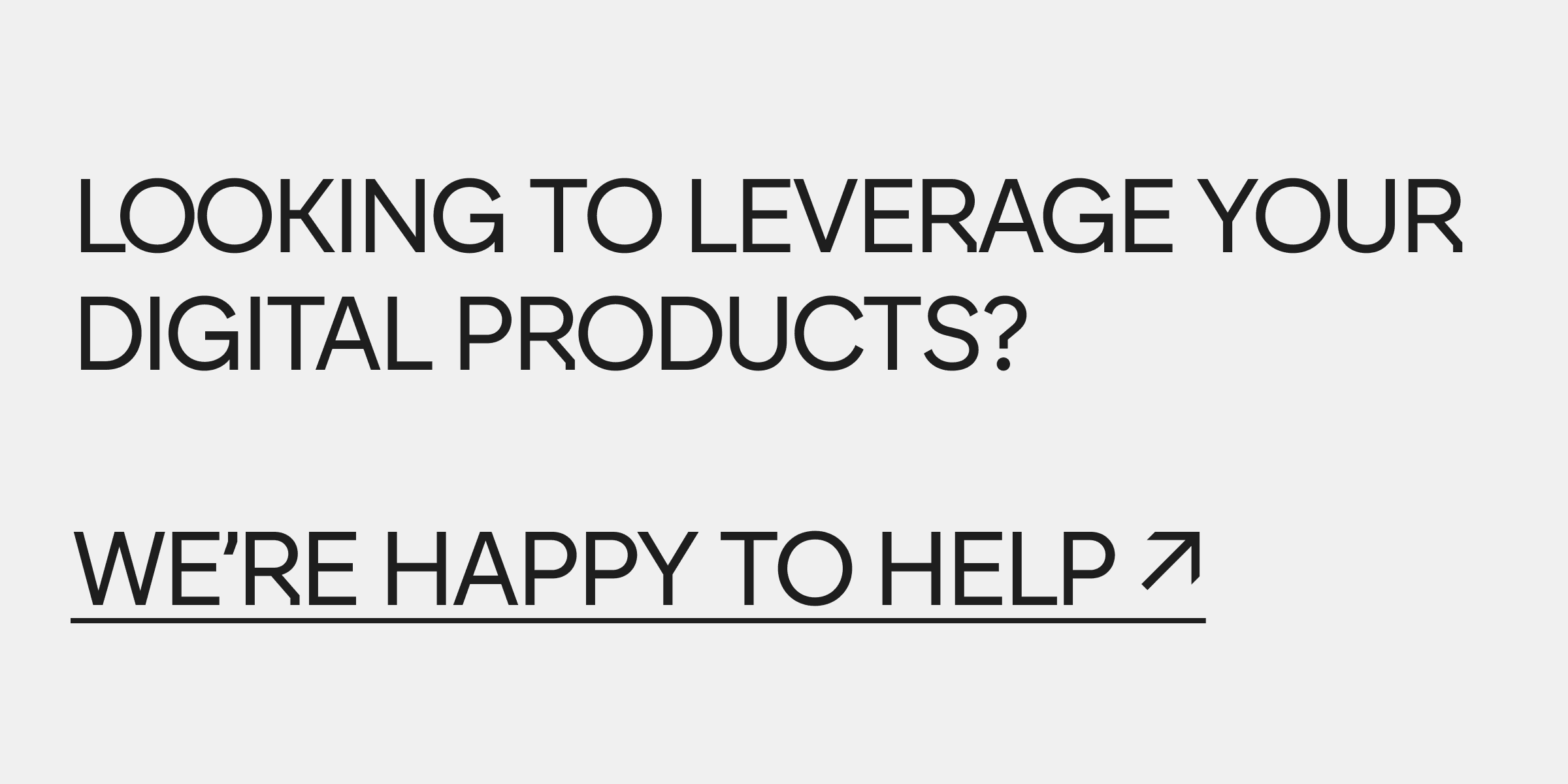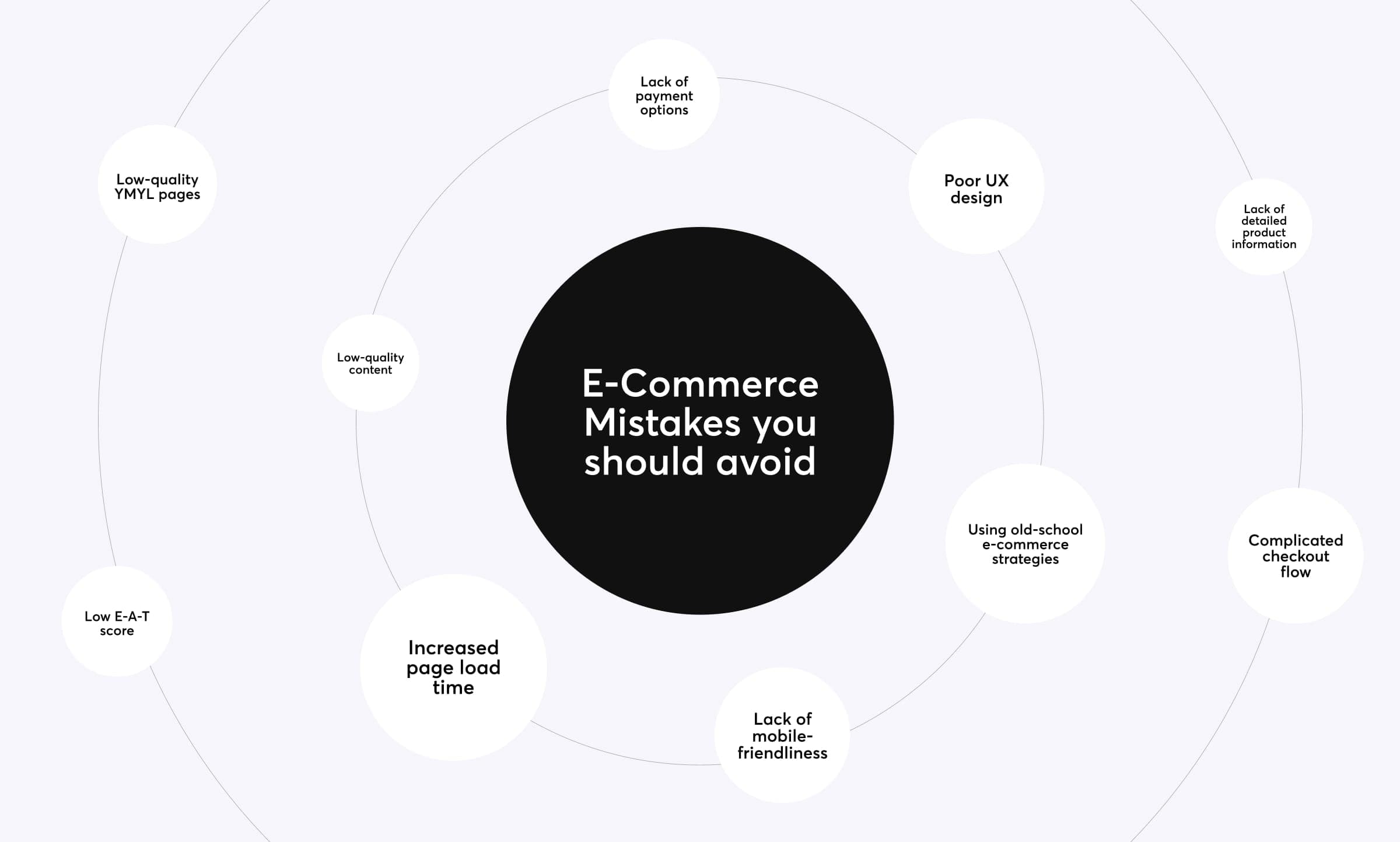The world of e-commerce is both a goldmine and a maze. With the digital revolution, countless online stores have sprung up, creating an immensely competitive landscape. While establishing an online presence is crucial, it's not the only factor for success. The key lies in not just attracting search engine traffic, but also in converting one's target audience into loyal customers. Even veteran e-commerce platforms can stumble, making inadvertent missteps that result in dropping conversion rates.
Amid such a bustling digital market, offering a smooth shopping experience is the difference between fleeting visits and successful sales. Don't know how to do it? In that case, it's safe to say that you came to the right place! In the following article, we're going to delve into mistakes to avoid if you want to achieve e-commerce success. Whether you're new to e-commerce or a seasoned player, understanding and rectifying such errors is bound to make it easy for you to rise above the competition.
What Is Conversion Rate In E-commerce?
Conversion rate is one of the most critical metrics in the e-commerce domain. But what exactly does it entail? At its core, conversion rate measures the effectiveness of a platform in turning its visitors into new customers.
The process of calculating it can be divided into three steps. First, you take the number of a store's conversions, such as how many sales it made in a day. Second, you divide the number of conversions by the total number of the store's visitors. Then, you multiply the result by one hundred percent to turn it into a percentage. For instance, imagine than an online store receives 1,000 site visitors in a day and 50 of the said visitors make a purchase. That store's conversion rate would be exactly 5 percent.
It's worth noting that the significance of conversion rate extends beyond mere numbers. It offers a snapshot of a site's effectiveness, gauging how well it's meeting consumer expectations. A high conversion rate typically indicates that a website's user experience, product offerings, and overall sales strategy are aligned with what its audience seeks.
Must read! Redesign This Page First To Double Your E-Commerce Conversion Rate!
10 Online Store Mistakes You Need To Make Sure To Avoid
As e-commerce continues to grow, ensuring that you stand out for all the right reasons becomes paramount. However, even seasoned merchants can fall prey to common missteps that could potentially undermine their store's success. So, join us as we shed light on a few common mistakes many business owners often make! By identifying, understanding, and strategically sidestepping such errors, you pave the way towards crafting an online shopping experience that isn’t just seamless, but also significantly boosts credibility and customer loyalty.
Increased Page Load Time
Consumers are no longer as patient as they once might have been. Each delayed moment risks frustrating potential customers, and the adverse effects ripple beyond just that single interaction. If a user encounters a slow-loading page, not only are they more likely to go somewhere else, but the negative experience could also deter them from returning in the future.
Factors such as oversized images, which might look attractive but are heavy on data, can slow a page down considerably. The same goes for an over-reliance on plugins, which, while adding functionality, might be bogging down the website. Similarly, the choice of a content management system plays a pivotal role. Choosing the wrong one could hinder the swift loading of pages. In some cases, creating one's own content management system is the best possible course of action. Not to mention, overlooking advanced web practices like lazy loading, which ensures that only the essential content is loaded immediately while the rest follows as the user scrolls, can also contribute to the lag.
Luckily, you don't have to take care of such things alone. A methodical review, perhaps in collaboration with a proficient developer or search engine optimization expert, can help you bring and address such issues in no time. Following such a review, you're bound to enjoy improved site performance, as well as a boosted conversion rate. For more insights on optimizing a store's speed, especially for Shopify users, check out our article on Shopify speed optimization.
Poor UX Design
User experience often stands as the dividing line between success and obscurity. First impressions, fueled by website design and functionality, play a monumental role in shaping a visitor's perception and decision to purchase a product.
To begin with, think about the navigation system. It acts as an online store's backbone. A confusing or intricate navigation structure can quickly deter potential customers. Remember, when visitors arrive, they're on a mission, whether it's seeking information, browsing products, or making a purchase. If the path to their destination is unclear or convoluted, they're likely to abandon the journey altogether.
Equally important are the product display pages. These are the virtual shelves and racks of the e-commerce universe. They should showcase products in their best light, providing all the necessary details without overwhelming the visitor. Poorly designed product pages, where images don't load correctly, descriptions appear jumbled, or essential details are hard to spot, can diminish the allure of even the most desirable items. After all, if a product isn't presented attractively or comprehensibly, why would a consumer invest in it?
For a comprehensive overview on website redesign and the importance of user experience, visit our article about the reasons to redesign a website. You could also have a look at our article about how user experience research can make a product great.
Low-quality Content
When we talk about content in e-commerce, it goes beyond mere text. It encompasses a broad spectrum that includes images, videos, reviews, and even interactive elements. Each of the above-mentioned things plays a critical role in narrating the product's story and value proposition.
Starting with product images, they often serve as the first impression of the item. Low-resolution, blurry, or inadequately lit images can immediately cast doubts in the minds of potential buyers. It's akin to showcasing a dusty or damaged product in a brick-and-mortar store. On the flip side, high-quality images, captured from multiple angles, offer the user a comprehensive view, addressing their apprehensions and feeding their curiosities.
Furthermore, the inclusion of just a single image can be a deterrent. Modern consumers expect to see products in various scenarios, settings, and angles, ensuring they gain a holistic understanding before committing to a purchase.
As for product descriptions, they should be more than just dry specifications or features. A product description should be an engaging narrative that highlights the product's benefits, its unique selling points, and its potential role in the user's life.
Here, outdated SEO practices like keyword stuffing can be particularly detrimental. It breaks the flow of the narrative, making it less engaging and harder to read. On top of that, it signals to search engines that the content isn't genuinely user-focused. Meanwhile, for users, encountering such content can raise red flags about the authenticity and reliability of the website as a whole.
Moreover, the era where content was limited to product pages is long gone. Blog posts, customer reviews, and even user-generated content are becoming integral to the e-commerce journey. These elements provide added layers of trust, knowledge, and community engagement. But like any other content type, quality is vital. Authentic, well-researched, and engaging content can position a brand as a thought leader and a trustworthy vendor in its domain.
In essence, content, when done right, can be the ultimate salesperson, working around the clock, addressing user concerns, highlighting product virtues, and nudging visitors towards making a purchase. Conversely, low-quality content can push them away, tarnishing brand image and reducing the likelihood of repeat visits and purchases.
Low-quality YMYL Pages
Your Money or Your Life (YMYL) pages stand at the intersection of information and high-stakes decisions. These pages contain content that, if inaccurate or misleading, can directly impact a user's financial stability, safety, or health. Consequently, search engines meticulously scrutinize these pages, applying stringent quality and credibility standards to ensure that the information disseminated is accurate, reliable, and trustworthy.
The quality of YMYL pages can not only shape the user's perception of an e-commerce platform, but also influence the site's overall search engine performance. Google places a paramount emphasis on ensuring that YMYL content comes from credible sources and is factually accurate, as misguidance in such topics can have tangible, detrimental effects on users' lives.
So, what encompasses low-quality YMYL content? This can manifest as information that lacks proper research and verification, doesn’t cite credible sources, employs a tone that may be perceived as non-professional, or provides advice that is not substantiated by expertise. Such content may misinform users, erode trust, and in the context of e-commerce, could directly contribute to lost sales and diminished customer loyalty.
In the context of e-commerce, whether it’s providing detailed and honest product information, offering financial advice, or selling products related to health and wellbeing, YMYL pages must be approached with a conscientious attitude. As much as they are opportunities to inform and guide the customer, they are also reflections of the ethical and customer-centricity of the business. Brands must prioritize ethical communication, transparency, and customer well-being above all else when creating such content.
Low E-A-T Score
Expertise, authoritativeness, and trustworthiness (E-A-T) is a metric emphasized by Google. The search engine gives significant weight to E-A-T when evaluating the quality and relevance of web pages, which stems from a commitment to Google users, ensuring they access reliable and high-caliber content.
For an e-commerce platform, navigating this metric is crucial. A diminished E-A-T score not only hampers its visibility in search results but also casts a shadow on its credibility. Consequently, potential customers might not discover the platform. If they do, might approach it with skepticism, regardless of the quality of the products or services offered.
Delving deeper into the components of E-A-T, expertise refers to the depth and precision of knowledge showcased on a site. In the case of online stores, it translates to many a rich product description, well-crafted content such as blog posts or buying guides, and any other material that underlines the brand's command over its domain.
The next pillar, authoritativeness, assesses the platform's recognition and esteem in its sector. It's the digital equivalent of reputation, built through mentions from established sites, backlinks from industry frontrunners, endorsements from notable figures, or even favorable reviews from consumers. A brand that garners mentions from top-tier publications or influencers in its field can elevate its authoritative standing significantly.
Lastly, trustworthiness examines the platform's genuineness and reliability. Factors like a secure browsing experience, clear and user-friendly policies, honest customer reviews, and consistent, accurate content play pivotal roles in bolstering this facet.
To ascend the E-A-T ladder, e-commerce platforms must adopt a multifaceted approach. Regularly updating content ensures that the brand remains relevant and showcases its continuous engagement with the industry. Integrating customer reviews and testimonials lends an authentic voice to the platform, vouching for its products or services. Furthermore, accentuating credentials, including industry certifications, affiliations with respected institutions, and endorsements, adds layers of credibility.
Using Old-School E-Commerce Strategies
Clinging to outdated strategies can be the Achilles' heel for even the most established online businesses. As technology advances and consumer expectations shift, the methods that once guaranteed success can now become barriers to growth. Today's digital consumers, armed with a plethora of choices and empowered by instantaneous information, seek more than just a transactional relationship with e-commerce platforms. They yearn for dynamic, personalized, and hassle-free shopping experiences that cater to their evolving needs.
One of the prominent shifts in consumer behavior is the increasing value placed on bundled offerings and time-sensitive promotions. Bundling products provides shoppers with perceived value and streamlines their purchasing decisions, saving them both time and effort in searching. Time-sensitive promotions, on the other hand, leverage the age-old psychology of scarcity and urgency. Such deals entice consumers to make immediate purchasing decisions, capitalizing on the fear of missing out on a good deal.
Yet, it's essential that these promotions remain grounded in fair pricing. Artificially inflating prices only to slash them later can erode consumer trust in the long run. Besides, with the rise of price comparison tools and platforms, consumers are better equipped than ever to discern genuine deals from mere marketing gimmicks.
Additionally, clear visibility of shipping costs and simple return policies have become critical elements of a typical e-commerce journey. Hidden costs or ambiguities in payment and return processes can sour the shopping experience, leading to abandoned carts and reduced chances of repeat business.
Furthermore, up-selling and cross-selling, when done right, enhance the shopping experience. Instead of being mere tactics to increase sales, they can be positioned as value-additions, used to recommend products that genuinely complement the customer's initial choice or offering upgrades that significantly enhance product utility. Such strategies not only boost the average order value but also amplify customer satisfaction.
Other valuable things you could start doing include investing into marketing automation, conducting market research, and putting time and effort into crafting a reliable online marketing strategy. To give an example, instead of posting things to social media at random times, you could figure out how to do it in order to reach a specific target audience. You could also read up on which marketing tactics are most likely to resonate with the people you're targeting, and start using the said tactics on purpose.
In essence, while the foundational principles of commerce remain unchanged, the tactics and strategies that a typical business owner employs in e-commerce must be agile, evolving in tandem with technological advancements and shifting consumer preferences.
Complicated Checkout Process
A potential customer who has journeyed through your site, made selections, and reached the point of purchase already exhibits a high intent. But a convoluted and perplexing checkout process can swiftly quench that intention, turning an almost-guaranteed sale into a missed opportunity.
For most customers, the ideal checkout process is like a well-lit, straight path. Each step should be intuitive, guiding the user effortlessly towards the goal. This involves minimizing unnecessary steps and presenting clear, concise instructions and prompts. A guest checkout option is a perfect example of this ethos in action. While businesses may have a vested interest in collecting user data for future marketing efforts, enforcing account creation can come off as obtrusive, especially to first-time visitors. Offering a guest checkout option acknowledges and respects the user's desire for a quick, fuss-free transaction, enhancing their overall experience.
However, the pitfalls to avoid don't end there. Unexpected costs or changes in the final tally, especially if introduced at the very last checkout page, can feel like a betrayal to the customer. No one likes surprises when it comes to parting with their money. For that reason, every hidden charge or compulsory add-on unveiled at the last minute increases the risk of cart abandonment.
All in all, the checkout process should be viewed as a continuation of the brand's promise to its paying customers. It should be about commiting to clarity, transparency, and respect. Brands that recognize this and prioritize simplicity and user-centricity in their checkout flow will undoubtedly see more carts crossing the finish line.
Lack of Mobile-friendliness
Mobile devices have become our indispensable companions. The convenience they offer, from quick searches to seamless online purchases, has led to an exponential rise in mobile-based e-commerce interactions. Given this backdrop, overlooking mobile optimization can cause you to lose a massive section of potential customers.
When it comes to e-commerce, the intricacies of mobile optimization become even more pronounced. Imagine a potential buyer on their morning commute, wanting to make a quick purchase. They land on a website, only to find banners that don't fit the screen, product images that take forever to load, or a checkout process that feels like navigating a maze. Such hurdles can lead to swift exits, abandoned carts, and, worst of all, a potential customer developing a negative perception of the brand.
So, what should a mobile-optimized e-commerce site have to offer? In our opinion, the most important things out of the bunch include streamlined navigation, efficient load times, and intuitive interfaces. It should understand the time constraints and attention spans of mobile users and aims to offer them the most efficient and enjoyable shopping experience possible.
Just remember that mobile optimization isn't a one-time task. As mobile devices evolve, so do user habits and expectations. Keeping abreast of these changes and continuously refining the mobile shopping experience can be the key differentiator between e-commerce platforms.
Lack of Payment Options
The days when a simple credit card checkout sufficed are long behind us. With technological advancements and the ever-evolving financial landscape, consumers are becoming increasingly accustomed to having a multiple payment options at their fingertips.
Imagine a scenario where target customers, after browsing an online store, filling their cart with desired products, and investing considerable time, find out their preferred payment method isn't supported. The frustration from such an experience can deter not only that particular purchase, but also dissuade them from returning, impacting customer retention and potentially resulting in negative feedback shared within their circles or on public platforms.
Keeping all of this in perspective, it's evident that for e-commerce sites aiming to cater to a broad and diverse audience, versatility in payment options is a necessity. Regularly revisiting and expanding the array of payment methods ensures that businesses remain in tune with market demands and technological advancements.
Moreover, it's not just about sheer quantity. Ensuring that these payment gateways are secure, efficient, and user-friendly is equally crucial. After all, even if a platform offers a wide range of payment options, if they're plagued with frequent transaction failures or security concerns, they will do more harm than good.
Lack of Detailed Product Information
Online shopping, while teeming with convenience, operates on a foundation of trust and clarity. Unlike traditional brick-and-mortar store where customers can feel, inspect, and even try out products before purchasing, online platforms rely heavily on their ability to convey a product's value, functionality, and attributes through digital means. For that reason, customers want to know the minutiae of what they're considering purchasing, and any gaps in this information can sow seeds of doubt, leading to hesitation and often abandonment of the process of shopping online altogether.
Consider the mindset of a consumer interested in buying a piece of clothing online. Without the ability to feel the fabric, try on the piece for fit, or inspect its stitching, they will rely on the product description to fill these sensory gaps. Details about the material, its breathability, its care instructions, its fit, and even its country of origin become pivotal in shaping the purchase decision. The same principle applies across various product category pages, from electronics where users may want to know battery life, compatibility, and warranty details, to kitchenware where the type of materials, usage guidelines, and maintenance tips can greatly influence the buying decision. If they end up encountering a poor product description, they might end up not making a purchase.
Furthermore, an interactive aspect can exponentially elevate the user experience. By integrating a section dedicated to frequently asked questions, or, better yet, allowing customers to pose questions directly on the product page, businesses invite engagement and provide a platform for real-time clarifications. Such practices not only contribute to the depth of information available, but also establish a dialogue, enhancing trust and adding to a company's customer service. Consumers are more likely to invest in a product when they feel their concerns are acknowledged and addressed.







